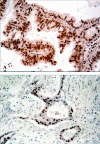Clinical significance of p16 protein expression loss and aberrant p53 protein expression in pancreatic cancer
- PMID: 16127777
- PMCID: PMC2815837
- DOI: 10.3349/ymj.2005.46.4.519
Clinical significance of p16 protein expression loss and aberrant p53 protein expression in pancreatic cancer
Abstract
Pancreatic cancer is a disease with poor prognosis mainly due to low resection rates and late diagnosis. To increase resectability and improve survival rates, a better understanding of pancreatic cancer pathogenesis and more effective screening techniques are required. New methods, such as genetic and molecular alterations, may suggest novel approaches for pancreatic cancer diagnosis and treatment. We immunohistochemically investigated 44 formalin-fixed, paraffin-embedded specimens of pancreatic ductal adenocarcinoma using monoclonal anti-p16 antibodies and monoclonal anti-p53 antibodies. The expressions of p16 and p53 proteins were compared using the Chi-square test with SPSS. Disease-free survival was analyzed using the Kaplan-Meier method, verified by the Log- Rank test. Loss of p16 expression was noted in 20 (45.5%) cases and aberrant p53 protein expression was detected in 14 (31.8%) cases. Loss of p16 expression was associated with a higher incidence of lymph node metastasis (p=0.040) and a more advanced stage (p=0.015), although there was no significant correlation between p16 expression and survival. Aberrant p53 protein expression correlated with histologic grade (p= 0.038). Disease-free survival rate was significantly lower in the aberrant p53 protein positive group compared to the negative group (p=0.029). From our results, we suggest that p53 is not a prognostic factor; however, p16 and p53 genes do play important roles in the progression of pancreatic ductal adenocarcinoma.
Figures




Similar articles
-
Immunohistochemically detected expression of 3 major genes (CDKN2A/p16, TP53, and SMAD4/DPC4) strongly predicts survival in patients with resectable pancreatic cancer.Ann Surg. 2013 Aug;258(2):336-46. doi: 10.1097/SLA.0b013e3182827a65. Ann Surg. 2013. PMID: 23470568
-
Aberrant p16INK4 expression related to clinical stage and prognosis in patients with pancreatic cancer.Int J Oncol. 1998 May;12(5):1111-6. doi: 10.3892/ijo.12.5.1111. Int J Oncol. 1998. PMID: 9538137
-
Prognostic prediction of the immunohistochemical expression of p53 and p16 in resected non-small cell lung cancer.Eur J Cardiothorac Surg. 2003 Feb;23(2):221-8. doi: 10.1016/s1010-7940(02)00749-2. Eur J Cardiothorac Surg. 2003. PMID: 12559346
-
Molecular genetics of exocrine pancreatic neoplasms.Surg Clin North Am. 1995 Oct;75(5):857-69. doi: 10.1016/s0039-6109(16)46732-0. Surg Clin North Am. 1995. PMID: 7660250 Review.
-
Familial pancreatic cancer and the genetics of pancreatic cancer.Surg Clin North Am. 1995 Oct;75(5):845-55. doi: 10.1016/s0039-6109(16)46731-9. Surg Clin North Am. 1995. PMID: 7660249 Review.
Cited by
-
Prognostic implications of cyclin B1, p34cdc2, p27(Kip1) and p53 expression in gastric cancer.Yonsei Med J. 2007 Aug 31;48(4):694-700. doi: 10.3349/ymj.2007.48.4.694. Yonsei Med J. 2007. PMID: 17722244 Free PMC article.
-
Genetic Signature of Human Pancreatic Cancer and Personalized Targeting.Cells. 2024 Mar 29;13(7):602. doi: 10.3390/cells13070602. Cells. 2024. PMID: 38607041 Free PMC article. Review.
-
Raised granzyme B levels are associated with erosions in patients with early rheumatoid factor positive rheumatoid arthritis.Ann Rheum Dis. 2005 May;64(5):715-21. doi: 10.1136/ard.2003.007039. Epub 2004 Oct 7. Ann Rheum Dis. 2005. PMID: 15471892 Free PMC article.
-
Can Molecular Biomarkers Change the Paradigm of Pancreatic Cancer Prognosis?Biomed Res Int. 2016;2016:4873089. doi: 10.1155/2016/4873089. Epub 2016 Sep 1. Biomed Res Int. 2016. PMID: 27689078 Free PMC article. Review.
-
Diagnosis of pancreatic lesions collected by endoscopic ultrasound-guided fine-needle aspiration using next-generation sequencing.Oncol Lett. 2016 Nov;12(5):3875-3881. doi: 10.3892/ol.2016.5168. Epub 2016 Sep 21. Oncol Lett. 2016. PMID: 27895743 Free PMC article.
References
-
- Ministry of Health and Welfare, Republic of Korea. Annual Report of the Central Cancer Registry in Korea (1997.1.1~1997.12.31) 1999.
-
- Yeo CJ, Cameron JL. Pancreatic cancer. Curr Probl Surg. 1999;36:59–152. - PubMed
-
- Crist DW, Cameron JL. The current status of the Whipple operation for periampullary carcinoma. Adv Surg. 1992;25:21–49. - PubMed
-
- Fernandez-del Castillo C, Rattner DW, Warshaw AL. Standards for pancreatic resection in the 1990s. Arch Surg. 1995;130:295–300. - PubMed
-
- Yoon DS, Jeong J, Park YN, Kim KS, Kwon SW, Chi HS, et al. Expression of biliary antigen and its clinical significance in hepatocellular carcinoma. Yonsei Med J. 1999;40:472–477. - PubMed
MeSH terms
Substances
LinkOut - more resources
Full Text Sources
Medical
Research Materials
Miscellaneous

